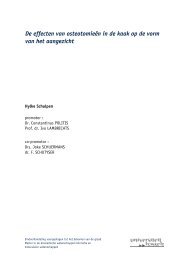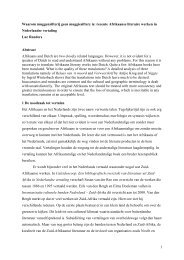Planning Problems in Intermodal Freight Transport ...
Planning Problems in Intermodal Freight Transport ...
Planning Problems in Intermodal Freight Transport ...
You also want an ePaper? Increase the reach of your titles
YUMPU automatically turns print PDFs into web optimized ePapers that Google loves.
A second operational plann<strong>in</strong>g problem of network operators is the redistribution of<br />
railcars, barges and load units. In Chih et al. [60] a decision support system called RAILS is<br />
set up to optimally manage <strong>in</strong>termodal double-stack tra<strong>in</strong>s. This assignment problem is<br />
complex as there are height constra<strong>in</strong>ts and choices between different modes. The system is to<br />
be used on a daily basis to ensure the correct size of each tra<strong>in</strong> and to generate rail car<br />
reposition<strong>in</strong>g <strong>in</strong>structions. The plann<strong>in</strong>g horizon is two weeks and takes the local and global<br />
system needs <strong>in</strong>to consideration. The problem is formulated as a non-l<strong>in</strong>ear multi-commodity<br />
<strong>in</strong>teger network flow problem. As the problem is NP hard, a heuristic method is developed <strong>in</strong><br />
order to be able to solve the network optimisation problem with<strong>in</strong> a reasonable time. The<br />
heuristic breaks the solution procedures <strong>in</strong>to several components and uses well developed<br />
traffic assignment and capacitated network transhipment optimisation algorithms to solve the<br />
problem. In Chih and Van Dyke [61] a similar approach is followed for the distribution of the<br />
fleet’s empty trailers and/or conta<strong>in</strong>ers.<br />
5.4 <strong>Intermodal</strong> Operator<br />
At an operational level an <strong>in</strong>termodal operator has to determ<strong>in</strong>e the optimal rout<strong>in</strong>g of<br />
shipments. Barnhart and Ratliff [62] discuss methods for determ<strong>in</strong><strong>in</strong>g m<strong>in</strong>imum cost<br />
<strong>in</strong>termodal rout<strong>in</strong>gs to help shippers m<strong>in</strong>imize total transportation costs. Their models are<br />
focused on the rail/road comb<strong>in</strong>ations compared to uni-modal road transport. Two types of<br />
decision sett<strong>in</strong>gs are identified depend<strong>in</strong>g on who owns the equipment and who is provid<strong>in</strong>g<br />
the service. When rail costs are expressed per trailer, m<strong>in</strong>imum cost rout<strong>in</strong>gs are achieved<br />
with a shortest path procedure. For rail costs expressed per flatcar, optimal rout<strong>in</strong>gs are<br />
determ<strong>in</strong>ed with a match<strong>in</strong>g algorithm and a b-match<strong>in</strong>g algorithm. The latter models are also









